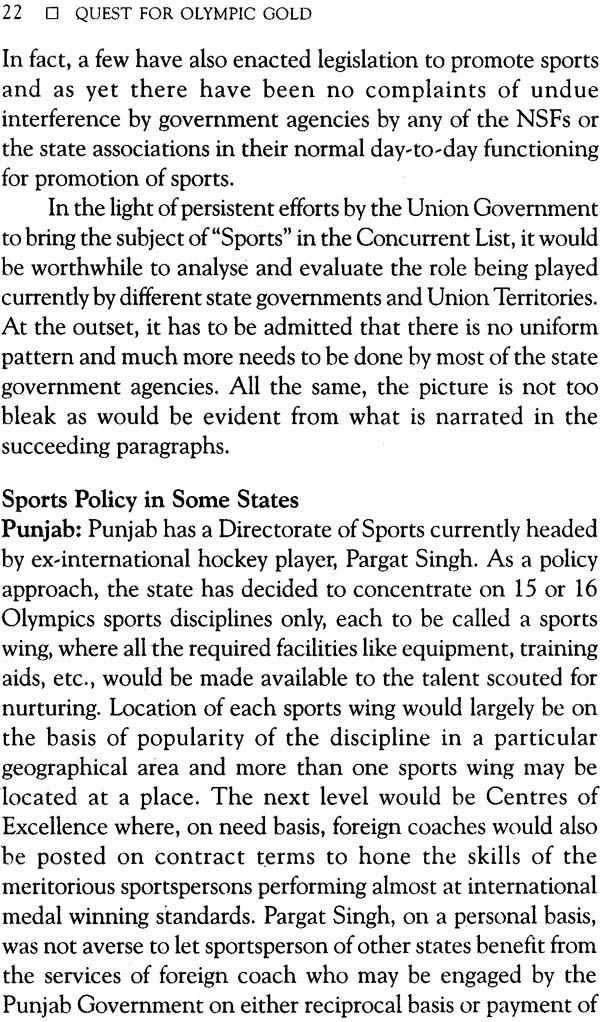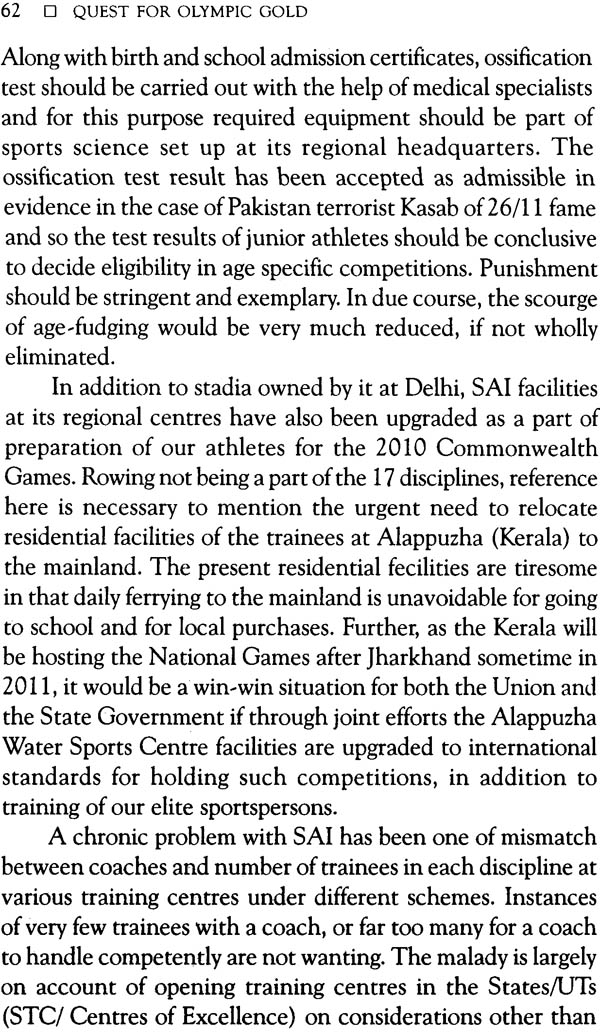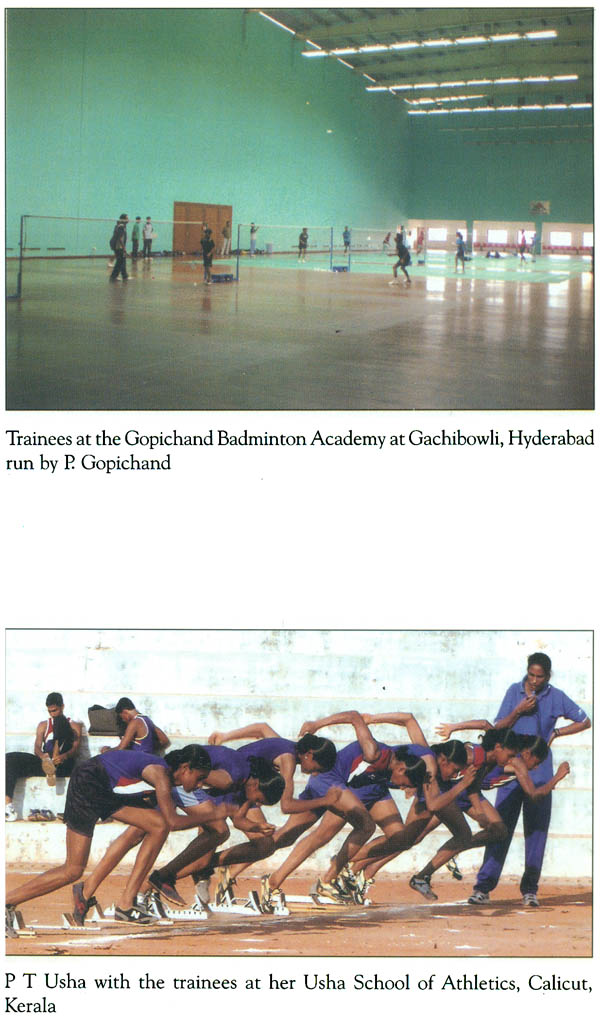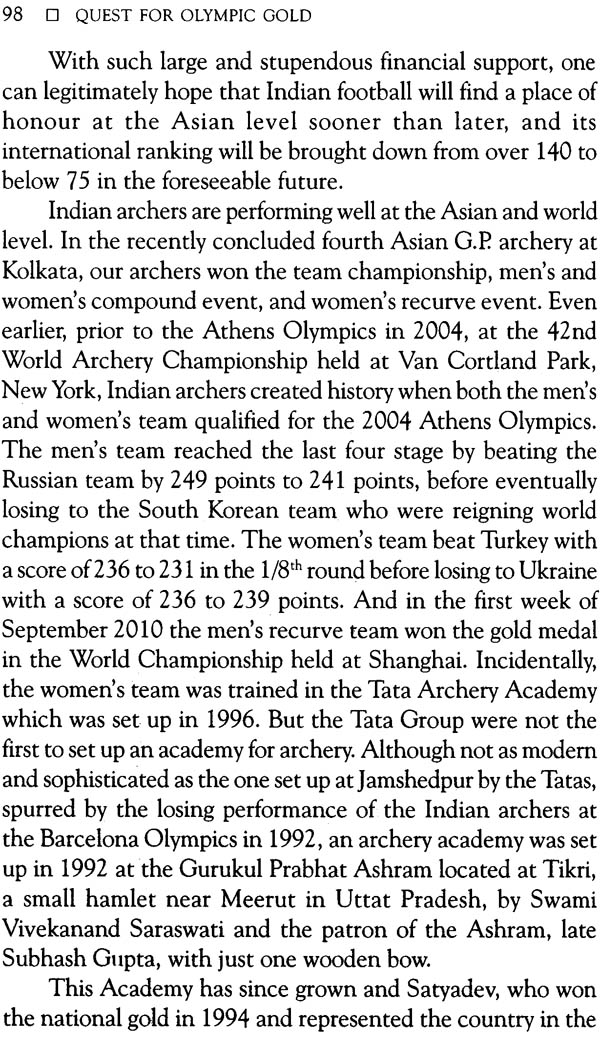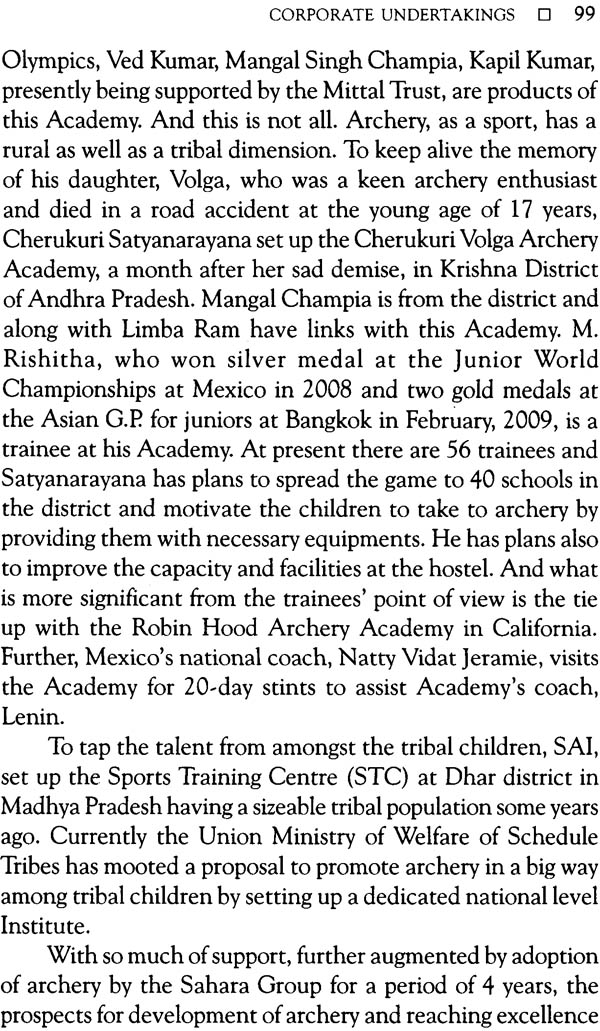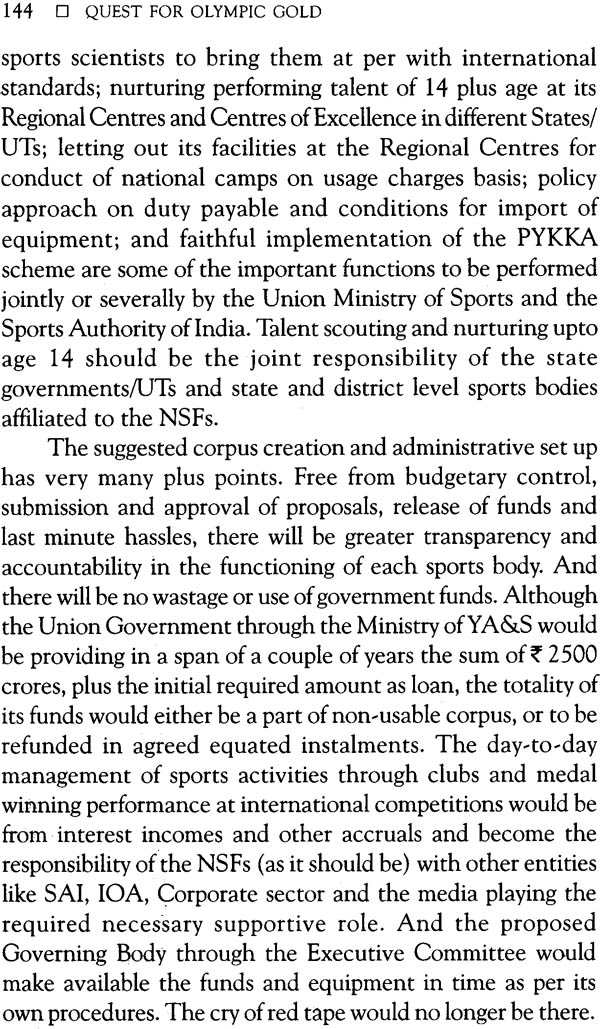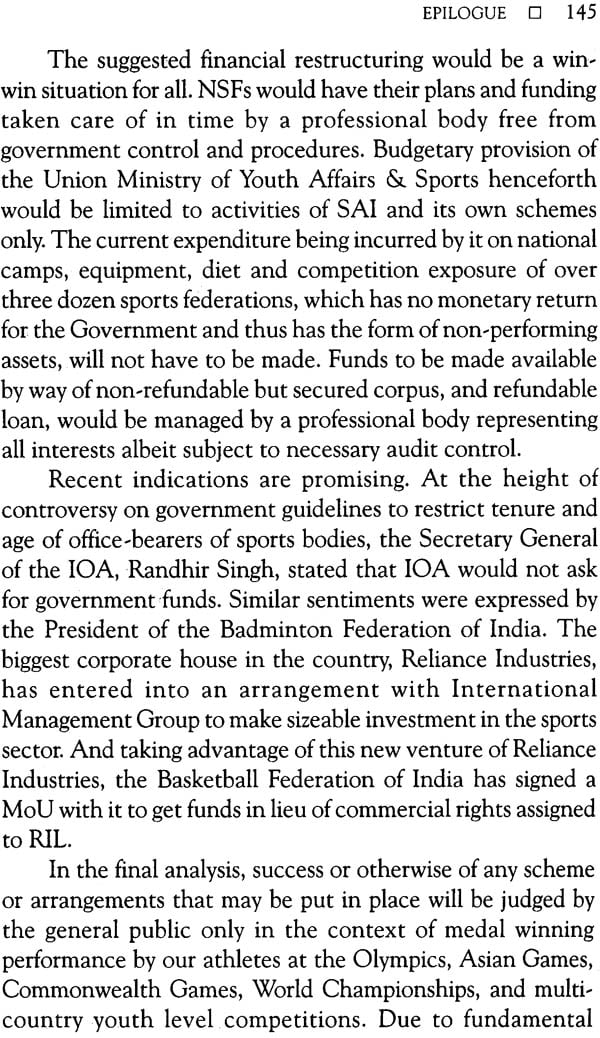
Quest For Olympic Gold (Strategies for Excellence)
Book Specification
| Item Code: | NAI187 |
| Author: | Arun Kumar Pandya |
| Publisher: | National Book Trust, India |
| Language: | English |
| Edition: | 2010 |
| ISBN: | 9788123759739 |
| Pages: | 164 |
| Cover: | Paperback |
| Other Details | 8.5 inch x 5.5 inch |
| Weight | 250 gm |
Book Description
Considering the fact that India has one of the largest human resources in the world, our rather dismal status among the sports playing nations has understandably remained one of our biggest national disappointments. After all, what ails Indian sports and what can be the way ahead to stake a respectable claim in the international sports arena? The book seeks to discuss this all in a frank manner while delineating the roles of various stakeholders like the state and central governments including the Sports Authority of India, Indian Olympic Association, National Sports Federations, Media etc. In the backdrop of the concrete achievements of placing adequate world class sports infrastructure for the Commonwealth Games in Delhi in 2010 and the euphoria, both good and bad, associated with the event, the present book takes stock of the required groundwork that have been done and further needs to be done in the country's quest to earn a rich haul of gold medals at the Mecca of all sporting events-the Olympics.
Arun Kumar Pandya (IAS, batch 1957, Madhya Pradesh cadre), has held various responsible posts in the state government as well as at the centre retiring as Secretary to the Govt. of India, Department of Youth Affairs & Sports and Director-General, Sports Authority of India (SAI) in 1992. An enthusiastic sportsperson himself during his school and college days having captained the school and college cricket teams and also represented the Delhi University in the 1950s, he has also served as Advisor (Sports) to SAI, Govt of Gujarat and Chairman, Kerala Sports Commission. Presently Vice-Chairman of Indian Olympic Association's Sports Commission, he is also Vice-Chairman, Commonwealth Games Technical Conduct Committee (GTCC), Delhi.
There are moments in history to be capitalized. For India, one such moment came in the form of closer Indo-Uf relations in 2007-2008 leading to signing of the nuclear deal in October, 2008, thus ending 34 years of nuclear isolation following the Pokhran test in 1974. For Indian sports, such a moment came in the aftermath of euphoria among sports enthusiasts in the wake of the first individual gold medal, won by Abhinav Bindra in shooting at the 2008 Beijing Olympic Games and a Bronze medal each in boxing won by Vijender Kumar and in free style wrestling by Sushil Kumar who recently followed up with the stupendous performance by becoming the first Indian wrestler to win gold medal at World Wrestling Championship at Moscow. This best ever performance was closely followed by our junior athletes topping the medals tally in the 3rd Commonwealth Youth Games held at Pune from October 12-18, 2008. No doubt, only nine sports disciplines-athletics, swimming, badminton, tennis, table-tennis, boxing, wrestling, shooting and weightlifting-were in the reckoning as against 17 disciplines in which competitions in the main Commonwealth Games take place. All the same, public expectations are now high and there is an all round effort to upgrade our sports infrastructure and training facilities. A sum of 678 crores has been sanctioned by the Union government to upgrade the playing facilities at the training centers of the Sports Authority of India (SAI) along with sports science back up so that training-cum-competition schedules of our athletes in all the 17 disciplines for 300 plus days can be conducted smoothly.
But the one time effort with focus limited to the 2010 Commonwealth Games is not the answer to the myriad problems facing Indian sports. Public enthusiasm and expectations, as also willingness of the Union and state governments and some corporate houses to make resources available for development of sports in the country, has to be capitalized through a well coordinated action plan involving all the agencies working in the field of sports promotion in order to make optimum use of available resources by avoiding wastage through duplication.
The oft repeated lament of a nation of 100 crore plus population not making a mark in multi-country competitions like the Asian Games, the Olympics and the world championships must come to an end sooner than later. In the context of India-China comparison in various fields of development, the attainments of China as a world sports power are before everyone to see and envy. Beginning with 1970, when it made its entry in the Asian Games, it today occupies the top position by overtaking USA in the medals table at the 2008 Beijing Olympics by a clear margin of 15 gold medals! Even though we agree that China's political system enables unhindered implementation of national goals not replicable in the type of democratic political system we have, this cannot be an excuse to be behind countries like Kazakhstan, Thailand, Iran and Uzbekistan as was the position in the 2006 Doha Asian Games where our rank was 7th in the medals table. The journey for an acceptable position in the Olympics is too long in that despite the best ever performance at Beijing in 2008, we were at position 50, behind countries like Latvia, Estonia, Mongolia, Ethiopia, Slovakia, Turkey, Zimbabwe, Thailand, Dominican Republican and many such smaller countries. Surely this level of performance cannot be accepted if we wish to organize the Olympics in the first quarter of the 21st century.
One has to admit that the road to excellence in sports at international level is a long and arduous one and the desired level cannot be reached in a short span of time. Many books have been written on the state of Indian sports covering different facets of its problems and development. This book is not about the history of sports in India, nor does it relate to performance of elite Indian sportspersons-past or present- from pie-independence era onwards. The focus in this book is on analyzing in depth why even after taking the lead and hosting the first Asian Games at New Delhi in 1951, there has been no significant progress in the performance of our athletes in multi, country competitions. As a matter of fact, there has been a downward slide, especially in hockey and football. In hockey, after winning the gold medal in the Olympics continuously from 1928 to 1956, and gold, silver or bronze medal intermittently thereafter, we failed to qualify for the 2008 Beijing Olympics. Why such a fall? As for football, from winning a gold medal in the inaugural 1951 Asian Games, we are nowhere in the reckoning even at the Asian level! What are the reasons for this unacceptable downfall?
There is no magic wand to reach the top of the ladder in international sports competitions. As stated earlier, the journey is a long one and a beginning to nurture the talent has to start when the child is as young as 5 years for the disciplines of swimming and gymnastics, and not later than 9 years in regard to other sports disciplines. Constant monitoring is also a sine qua non with the help of sports science experts to either weed out or change the discipline of the trainee in the light of aptitude performance, physiological growth and related parameters so that time, energy and resources being spent on training do not go waste.
Emphasis on sports and physical activity the world over is pretty high as is evident from dedicated pages in the national and regional newspapers in every country and a host of TV channels covering sports competitions round the year. The spin off benefit of a healthy population is very much recognized, especially in the developed countries, but acceptance at home is wanting. How committed we are as a nation to excel in sports at international level is a question that requires an in depth analysis of the role of various agencies involved in sports promotion, i.e., the Union and the state governments, Union Territories, the Indian Olympic Association, Sports Authority of India, the National Sports Federations (NFSs) and its affiliated units, the corporate sector and the media. Are the various entities performing their legitimate role and functions diligently towards the common objective of assisting the athletes to perform at their very best in international competitions? Why has there been a gradual decline in the level of sports activities in schools, colleges and universities? Is it true that lack of infrastructure is the main problem facing Indian sports today? Is the available infrastructure with the Sports Authority of India at its headquarters in Delhi and the regional centers of required international standards? Are the state governments optimally utilizing the sports facilities created at the time of holding the National Games? Is the content of academic courses being run currently for sports coaches and sports science of the required international standards?
Shortcomings and problems are many and there are no easy solutions. Individual brilliance of dozens of players from Balbir Singh Sr to Dhanraj Pillay (hockey); Ramanathan Krishnan and Vijay Amritraj (tennis); Nandu Natekar,
I was delighted to learn that Shri A.K. Pandya, IAS (Retd.) has penned a book on Indian sports for the National Book Trust, India.
An outstanding sportsperson, administrator, organizer, mentor to the central government and many state governments, public sector organizations, corporate sector, Sri Pandya's passion for sports and sports persons is remarkable. His 'Quest for Olympic Gold' is unique in the sense that-he has addressed all stakeholders in Indian sports, their functioning, analysed the problems, suggested possible remedies and course corrections to lift Indian sports to greater heights.
What is heartening and gratifying is the fact that he has put "the athlete at the centre stage" in the words of Carl Lewis at the Atlanta Olympics games, their pains and problems, application and integration of sports sciences from talent identification to achieving excellence and glory for India, under Indian conditions, legal and constitutional framework. Today's sportspersons are as much a scientific product as a commercially sponsored product requiring deft marketing, coordination, responsibility and accountability.
I am sure this book will be useful tool to all stake holders who are passionate about sports.
| Foreword | ix |
| Acknowledgement | xi |
| Introduction | xiii |
| The Union Government Facilitator, Catalyst, Trend Setter | 1 |
| State Governments and UTs 21 School Sports, Talent Scouting and Nurturing | |
| Sports Authority of India Infrastructure, Equipment and Excellence Training Support | 48 |
| National Sports Federations Club Culture, Competition Exposure and Excellence Training | 66 |
| Corporate Undertakings Game Adoption, Financial Support and Employment | 83 |
| Indian Olympic Assosication Guide, International Support and Regulator | 110 |
| Role of the Media Analysis and Interpretation | 130 |
| Epilogue | 137 |

